Voici un article simple mais très intéressant en anglais consacré aux véhicules oscillants. Il date de 2015.Nous avons là une source de réflexion et de références documentées sur le sujet de l’oscillation des véhicules. Les notions contenues dans cet article et les solutions techniques proposées par RARTRIKE-France montrent déjà le chemin parcouru par notre entreprise dans cet axe de recherche… Bonne lecture… You’ll improve your english, I Think…
Tilting Human Powered Trikes: Principles, Designs and New Developments.
 Stephen Nurse1, Mark Richardson1, Robbie Napper1
Stephen Nurse1, Mark Richardson1, Robbie Napper1
- Faculty of Art, Design & Architecture, Monash University, 900 Dandenong Rd. Caulfield East, Vic 3145
Email: ssnur1@student.monash.edu
Abstract
Motorised and unmotorised tilting trikes are a relatively new transport development. This paper focuses on unmotorised tilting recumbent trikes (tilters). They are part of the family of recumbent cycles which can have lower wind resistance and travel faster for the same effort than more conventional cycles.
The paper finds that tilting trikes inherit leaning and dynamic stability characteristics from bicycles and the potential for static stability from trikes. Tilting removes the need for a trike to be wide and low to stay stable during cornering. This can make the trikes more visible and acceptable from a car driver’s perspective compared to a standard, low recumbent trike.
High-end tilting trikes can have hybrid (human / electric) drives and meet the need for comfortable, sheltered vehicles capable of taking luggage on long commutes. These expensive high end tilters are not widely available in Australia. Less complex tilters can be better-than-bicycle practical vehicles with features such as stability when stopped, integrated luggage capacity, ease of starting and improved aerodynamics.
This paper aims to fill a knowledge gap concerning tilting trikes’ advantages, disadvantages, likely cultural acceptance, motion physics and potential to modernise the fleet of pedalled transport vehicles. Examples are discussed and a new, simple design is introduced.
-
Introduction
As city commutes by car become longer due to suburban sprawl, alternative-vehicle travel is becoming increasingly appealing. One recent Melbourne commuter race recorded car travel times of 97 minutes for 27km. In the same race, a slower but less obstructed cyclist travelled between the same points in 67 minutes (Dow, 2014). In many instances, one person on a bicycle is an appropriate use of transport, adding negligible traffic congestion compared with one person in a four person car.
Transport needs to be sustainable not just from a noble “use resources sparingly” point of view, but also from a practical, personal perspective and increased use of cycles could help. All sorts of cycles could be in abundant use, and these include recumbent cycles, cargo bikes, velomobiles and electric bikes. These comparatively new “improved cycles” include tilting trikes and can be “better-than-bicycle” with combinations of enhancements such as having extra power available, good aerodynamics, larger load capacity, extra stability when stopped, and added weather protection.
Taken as a whole, “improved cycles” could increase the number of days of cycle use (in wet weather), range of cycle use (distance travelled on commute), range of participants and range of cycle uses. (holidays, shopping, ferrying kids to school, social visits etc.) These sorts of trips could replace car journeys, resulting in reduced traffic congestion for all (Cox 2009, p. 37, Nelson 2010, p. 47). While tilting trikes exist in the motorised transport space, this article focuses on the small but growing category of unmotorised recumbent cycle, the Tilting Three Wheeler, Tilting Trike, Tilter, or Narrow Tilting Vehicle. For this article, “unmotorised cycles” includes those that have up to 250W of electric assistance in line with Australian bicycle laws.
Figure 1: Low delta racing tilter and high, narrow tadpole tilters (www.fastfwd.nl, Drymer 2015)
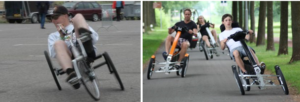
There are many definitions associated with this topic and a glossary is included. The most common terms are Delta trike: a trike with 1 wheel at the front, Tadpole trike: A trike with 2 wheels at the front, NTV: Narrow Tilting Vehicle.
Leaning is synonymous with all two wheeled bicycles, but it is not standard on 3 or 4 wheel vehicles. So I describe tilting in an NTV as “the ability of a vehicle with apparent static stability (three or more non-collinear wheels) to lean into corners and keep all wheels on the ground”
Figure 2: Human powered tilters in context (Authors sketch after Van De Walle 2004)
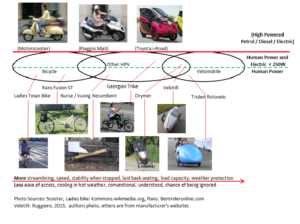
-
Comparisons and Cultural Acceptance
2.1 Comparisons
Compared to standard trikes, tilters have the option of a high yet narrow design. This means they can be visible in traffic yet able to travel on bike paths. Although static stability is optional (via a tilt lock), tilters will almost always have better stability when stopped than a standard bike (Karnop 2004, p. 147, Nurse 2009, p. 35). Tilters need to have a specific tilting mechanism, and designers need to pay attention to this as well as standard cycle considerations of suspension, aerodynamics, ergonomics and weight. Without careful attention to design, complexity and cost could overwhelm the ability of a manufacturer to make a high quality, profitable trike.
Costs for tilting trikes will inevitably be higher than the cost of mass produced bicycles due to relative complexity and / or low production volumes. This applies equally for recumbent bikes, trikes and velomobiles. Cost is less relevant when one considers that the buyer will probably value the cycle for enabling exercise or commuting. For these buyers, prices comparable to an inexpensive secondhand car may be tolerable.
The footprint or size of tilting trikes is another factor. Similar to cargo cycles, tilters can be longer, wider and heavier than bicycles. Users and designers would need to develop workarounds for parking them at home or in public places, or carrying them by car and on public transport, where accommodation is almost always designed for the bicycle.
2.2 Cultural Acceptance.
Figure 3: Toxy Recumbent Bike, Burrows Recumbent Trike, Alleweder Velomobile (Wikemedia Commons)

Recumbent cycles are available within broad categories of recumbent bikes, recumbent trikes and velomobiles. Tilters can now be added as a new category. Because tilters are so new, considering their cultural acceptance means looking at the acceptance of other styles of recumbents. The availability of recumbents has increased in recent years with online purchasing, good competition between manufacturers in Australia, Europe, America, Taiwan and China and a thriving secondhand market (OzHpv 2015).
On the other hand, recumbents receive little press coverage and are seldom observed on cycle shop floors or on the road. They are generally only understood by the devotee. Observations are that recumbent riders are mostly male, of a high average age and that some riders only come to them as the result of injury. There can be a negative perception of recumbents as an older person’s vehicle (Koeppel, 2006).
Negative perceptions can be overcome, however. The power assistance electric bikes offer is enabling for daily commuting without sweat over distances of 15 to 20 kilometres. A few years ago, dependence on recharging, lack of purity compared to a bicycle without a motor, increased weight and use of toxic chemicals were all been cited as drawbacks for these cycles (Nelson 2010, p. 47, Burrows 2008, p. 208).
More recent articles (Acott 2015, Haberfield 2014) indicate electric bike sales are increasing and that they have reached widespread acceptance. Although it is out of scope to analyse this, the recent uptake of electric bikes indicates that with the right engaging products at the right price at the right time, new styles of cycles can succeed in the market. Compared to an electric bike, recumbents and tilters can be deemed a purer, less motorised form of high functioning cycle and could be promoted as such.
-
Motion Physics and Control
3.1 Aerodynamics and general characteristics.
Recumbent cycles including tilters can have lower wind resistance and travel faster for the same energy input than more conventional cycles. They hold most records for cycling speed and distance travelled but were banned from UCI (Union Cycliste International, a cycling governing body) sanctioned cycle competitions in 1934, removing them from mainstream sports coverage (Kyle 2004 p. 146, Van De Walle 2004 p. 59). Their main feature is often aerodynamics but this does not preclude other practical features.
Figure 4: Aerodynamic / load carrying round Australia recumbent bike (Oakman 2014)
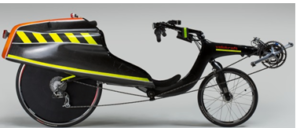
Specific events and advantages can be used to illustrate. Peter Heal holds the record for the fastest unsupported lap of Australia with 15000km covered in 48 days on a highly efficient recumbent bike with built in luggage space (Oakman 2014). Recumbent trikes offer static stability, allowing riders to go as slow as they like without losing balance. Many modern velomobiles were developed from the Dutch “Alleweder” machine which won a 1993 magazine sponsored “Year-round-cycling” HPV competition requiring weather protection, low maintenance, a high average speed for an hour and 15kgs of luggage carried in a 80 litre storage space (Nurse 2009, p. 35, Berchicci 2005, p. 135).
Commuting cycles can be compared with recumbents in quantitative terms using mathematical models. The scientific reason for the reduced effort when pedalling recumbents compared to other cycles is a reduction in the drag coefficient (Cd) and frontal area (A). Both are crucial elements of the equations governing cycle speed (Van De Walle 2004, p. 59). Drag coefficient and frontal area can be determined by wind tunnel testing, however for a particular cycle, estimates of these values can be made based on published tables (Gross 1983).
3.2 Tilting and Balance.
Bikes require active balance to ride and are dynamically stable. In a straight line, the rider keeps the bike’s centre of gravity above the line between the two wheels by small steering inputs. Superimposed on this is leaning, ie, keeping balanced when cornering by countering an outward centrifugal force with an inward gravitational force. The force on bike wheels is always close to 90 degrees to the wheel axis (Karnop 2004, p. 147).
Non leaning trikes are statically stable. They will tip when cornering shifts their centre of gravity outside of the “stability wedge” defined by the space above their tyre contact points, but riders can forestall tipping by moving their centre of gravity, shifting body weight into the direction of a corner. Resultant forces on non-leaning trike wheels are not at 90 degrees to the wheel axis, and this increases the requirement for strength in trike wheels. For reasons of stability, non-tilting recumbent trikes are often low with a wide track, and their lack of height can make them hard to see in traffic.
Adding tilting to a trike can make it revert to bike-like handling, simplifying tight cornering and allowing a high, narrow vehicle to be dynamically stable.
Figure 5: Low delta trikes racing on a winding course. Without tilting, tipping occurs. (www.recumbents.com/wisil/hpra.htm, Manchester 2008, Indy 2010)

3.3 Steering, Handling and Geometry
The design of bicycles is mature. Riders and purchasers usually know how to ride and what to expect from the handling of racing bikes, mountain bikes and ladies-frame bikes. Recumbents and tilters are newer cycles, and customers require greater belief to accept them. Designers should make riding them as accessible as possible by taming and simplifying their ride characteristics.
Tilting human powered trikes can become intricate machines with elaborate engineering and mechanisms unless there is a “decoupling” of the various requirements for driving a wheel, steering, braking, tilting and suspension. The most complex set of these requirements is for a tadpole leaning trike, where the drive to the back wheel is straightforward, but tilting, reaction to camber, braking, Ackerman steering and reasonable suspension must all be resolved between two mechanically linked front wheels (See Figure 6 below).
Riders “stand on the pedals” of bicycles as they traverse bumps, moving their body away from the seat, letting the tensed legs act as suspension. This can’t be done on a recumbent making suspension desirable, especially if there are small wheels or wheels right under the rider which promote jolting of the frame. Small wheels rise more quickly than large wheels over a given bump and due to a decreased lever distance, riders feel a greater proportion of the bumps traversed by wheels close to the body (Nurse 2009, pp. 9-11).
Most delta tilters use control which can be the same as bicycle tilting, while tadpole tilters use “lean to steer” like skateboard steering, or other manual control. The “Tripendo” tilting tadpole trike is described: “rider, frame and all three wheels lean in parallel by up to 26 degrees, and this is controlled by the right hand control lever”. (Davidson 1999, p. 101)
Trikes should have Ackerman steering geometry to ensure that wheels do not “fight each other” or scrub during cornering. This requires the lines perpendicular to the trike rims to be coincident whatever the steering angle (Nurse 2009, p. 39).
The phenomenon of braking a cycle affecting steering is called brake steer and it can be negated by having the steering axis or kingpin line of a trike wheel coincident with the tyre contact point, and similar principles apply to “bump steer”. These affects tadpole trikes only, most delta trikes have bike like steering where brake and bump steer is automatically cancelled. Superior leaning tadpole trikes have highly bespoke hub centre steering, which overcomes compromises in kingpin steering (Wianecki 2003).
-
Technology Review
This brief technology review gives examples of tilters which are on sale or have been developed and discusses the available information. This places the new “NV02” trike in context and should simplify further research. Motivations for building new styles of tilter are not always commercial and range from wanting to win a race, to wanting to try a concept, to wanting to share a concept. Sharing of tilting trike related ideas on blogs, bulletin boards and on-line video sites is common and these are sources which researchers should not ignore.
There seems to be no current production of tilting tadpoles without electric assist, possibly because they can be heavy, complex, less aerodynamic and are competing with simpler non-tilters. Manufacturers may struggle to sell these trikes at the high price required to offset costs. Simpler delta tilters are gradually coming into production, as are high-functioning, expensive electric assist machines.
4.1 Tadpole trikes
Figure 6: Tripendo Tadpole Tilter (Davidson 2009, p. 101)
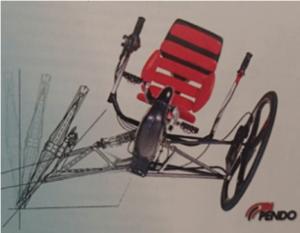
In 1995, US patent 5762351 was filed for a tilting tadpole trike. This “Aileron” trike did not reach production. (Soohoo 1998) Several tadpole leaning trikes have followed to the “proposed manufacture stage”, and the dominant configuration for these is 2F3T. (see appendix 1) Amongst them are the German Tiefflieger (Kautt 2010) and FN trike (Fleiner 2011). Few trikes in this category reach full manufacture. The Tripendo is a notable exception, but even this trike was only made from 1999 to about 2010 (Davidson 1999, p. 101, recumbentblog.com, 2010).
4.2 Delta trikes
Figure 7: Delta Trikes: Culty trike, Sims and Voung rear wheels and tilting mechanisms (www.culty.de, Thomas 2007, Vuong 2015)

Paul Sims who worked for Greenspeed in Australia designed and built a 1F3T front wheel drive tilter in 2000. This was an inspiration for a range of US and European designs of racing trikes including the John Morciglio fully faired tilter and the Munzo commercial lowracer (Sims 2000, jnyyz, 2012, Smit 2015). On the Sims trike, the back wheels stay parallel to the frame and tilt with it in corners, decoupling and simplifying many of the requirements for a tilter. It is a “virtual bike” with the rider experiencing bike-like handling.
Vi Vuong’s 2013 trikes are even simpler and work similarly way to Sims trikes, keeping the wheels parallel to the frame during a lean and providing a form of suspension. A pedal housing with cranks carries the set of two back wheels (Nurse 2013). Alexander Petraj from Greece and I have taken the Vuong design further by building trikes using the same mechanism. In February 2015, Cruzbike company owners Jim and Maria Parker tested and raced a Cruzbike converted to a trike with a “Vuong trike adapter” (Vuong 2015, Parker 2015).
In 2015 Alan Page publicised the “Trivek” 1F1T tilter and is beginning manufacture in Perth, Western Australia. This trike uses “in and out”, through the hub gearing which is functionally equivalent to a multigear Penny Farthing (Page 2015, Vittouris 2011, p. 13).
4.3 Trikes with electric assist
The Drymer from the Netherlands is an expensive electric assist leaning tadpole recumbent trike costing from 5780 EU to 9000 EU in May 2015. It is a trike providing rain and wind protection sold in a cold climate. This adds real practical value to allow for low stress commuting in almost all weathers. It is possible the high cost of the Drymer can be absorbed because of perceived good value in a society that already values sustainable transport (Drymer 2015).
Canadian Georgie Georgiev is famous for building handcycles and record breaking speedbikes. His tilting trike has a 1F1T leaning Delta configuration, electric front wheel drive and a human powered rear wheel. The trike does not have weather protection but has many other requirements for a high end tilting trike including a simply accessible luggage storage area (Georgiev 2008).
The Velotilt is an experimental leaning Delta trike / velomobile and a high end fast machine aimed at making commutes at 40kph possible. The rear wheels are outside the rider’s pod freeing up space for luggage. It is intended to be ridden fully enclosed but would seem to share some ergonomic issues with streamlined Velomobiles, ie getting in and out and accessing luggage could be difficult and a buildup of heat could cause issues. (Ruggiero 2015).
4.4 Further Reading
This survey covers only a few human powered tilting trikes. Many more exist including upright / non-recumbent tilters. Outside of patents, there seems to be little public research on unmotorised tilters, however there are on-line sources of information. Henry Thomas has designed the Jetrike and lists trike patents on his website (Thomas 2007). Craig Cornelius has developed a set of criteria for light commuting vehicles (Cornelius 2015). Phillipe Girardi has designed motorised and unmotorised tilters and compiled tables of tilting trike patents (Girardi 2015). Peter Eland provides a guide to tadpole trike steering design for non tilters which can be supplemented by Rick Wianecki’s work on tilters (Eland 2015, Wianecki 2003). Lastly, a video compilation provides links to a large number of videos (tiltingvehicles 2015).
There is a large body of public research and patents concerning motorised tilters. This research supports manufactured models such as the Piaggio MP3 and Toyota I-Road. These machines have complex tilting and “tilt lock to stay upright” systems controlled by electronics and actuated by hydraulics. Tilting and lockout can respond to manual switching and inputs from speed, road camber, engine rpm, and tilt angle (Karnop 2004, p147).
Online literature searches using terms “Tilting three wheeler” and “Narrow tilting vehicle” yield technical articles and patents on motorised trikes. “Leaning OR tilting AND « recumbent trike » OR « recumbent tricycle”” leads to unmotorised trikes where the majority of results are patent applications.
-
Proposition: Nurse – Vuong Tilter
The Audax and OzHpv cycling clubs are part of the culture shaping HPV building in Australia. Training for Audax rides can include long-distance on-road commuting by bike and this influences designers to make safe, aerodynamic, load carrying recumbent HPV’s. Some riders extend their involvement in riding by the enjoyable technical challenge of making or modifying the HPV’s they ride.
My HPV design and building work was well advanced when involvement with Vuong trikes began. Self-made recumbent bikes (some with hollow timber frames and NC routed plywood seats) had finished many single-day rides of 200 kilometres. These bikes had an original layout, including front wheel drive, twin front brakes and an aerodynamic, load carrying tailbox. (Nurse 2009, p. 75, Nurse 2011).
Work started on making a version of a Vi Vuong trike after seeing Vi’s 2013 videos. The first trike (“NV01”) is a grafting of a Vuong wheelset onto a basic bike made in line with my existing bike-building practices. The special back wheels which screw into standard bike cranks were a mash-up from old pedal pins and bike wheels. The frame is a piece of builder’s lumber. (Vuong, 2015).
Figure 8: Vi Vuong’s trike, Hollow frame wooden bike, NV01 trike (Vuong 2015, author’s photos)

Braking of the centre wheel of Vuong trikes fixes the wheel relative to its supporting crank and could cause instability such as lifting of the rear axle and flipping of the two back wheels. For this reason it is difficult to brake the back wheels of the Vuong setup. Fortunately having two front brakes meant braking of the back wheels was unnecessary. With the braked front wheel well in front of the relatively low bike CG there is little chance of tipping over during sudden braking as shown in figure 9 (Nurse 2009, p. 93). Extensive use of NV01 instilled confidence and convinced us the design deserved further attention. An online article gave further insights into the trike design (Nurse 2013).
Figure 9: Estimated CG positions (red dots) on triathlon and long wheelbase recumbent bikes (Wikemedia Commons, Instructables.com)
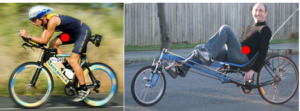
Figure 10: Instability on braking the centre wheel of a Vuong trike. (Author’s sketch)

5.1 Engineered Nurse – Vuong Tilting Trike “NV02”
Figure 11: NV02 Trike Frame Construction and NV02 trike (Author’s Photos)
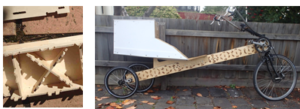
The key features of my second generation Voung trike “NV02” are a semi-monocoque, beam shaped frame and plywood seat. The frame and seat parts were both routed from a single sheet of 4.75mm plywood designed using the free 2d cad program DraftSight. Dxf files were used to communicate designs to a contractor. “Single sheet” is a construction technique noted for its simplicity and lack of waste, used to make chairs, boats, toys and surfboards. Techniques used to make the structural, engineered Vuong frame resemble those used for making hollow wooden surfboards since 1932 (Blake 1932). The frame and seat have no tooling costs.
This was the first test of a cycle with this frame construction. It performs well on my 30 kilometre round trip commute. The trike weighs 16.2 kg compared to 17.1 kg for an equivalent hollow frame wooden bike and is well received by fellow cyclists. It has an inbuilt load carrying capacity calculated at 56 litres which has been used for shopping trips. Part of the research into this and other Vuong trikes includes documenting all the travel done. 1570 km had been completed from June 1, 2015 to August 24, 2015.
If many more of this type of HPV were made, the design should be audited according to AS/NZS 1927, Pedal Bicycles Safety Requirements. Tricycles are out of scope of this bicycle standard, but AS/NZS 1927 still includes applicable safety measures, such as removal of parts with sharp edges and safe mounting of handlebar assemblies (Aust_Standards 2010).
-
Conclusions.
“The public is willing to accept new forms for machines performing new functions, but when century-old objects like a spoon, a chair etc. are involved, it’s not easy to make new aspects accepted. If men fear novelty, let’s give them something even more novel.” Italian designer Giullio Castelli (Fiell 2003, p. 116)
Tilting trikes can be categorised as high functioning cycles and offer an under-utilised option in the transport mix. They seem eminently suited for short to medium distance load-carrying commutes of 1 to 20k each way. Design and promotional focus should be on ease of use and potential to replace trips where automobiles are the current default option. Field tests show that tilters are practical vehicles, can be ridden quite fast in street clothes, are good for shopping trips and offer beneficial exercise.
Front wheel drive recumbent bike designs can be reworked as tilting trikes using Sims and Vuong rear wheel mechanisms. The Vuong mechanism is simple, making it a good option for do-it–yourself construction. This paper’s research focused on taking this simplicity further by developing the all-in one, beam shaped body structure which eliminates rear wheel triangles and frame splitting.
Vuong style trikes are a good candidate for popularising recumbent HPV’s. Any perceived high cost could be offset by providing parts in a kit form, a sales tactic which worked well with initial sales of the Alleweder Velomobile (Berchichi 2005, p. 136).
Commuter tilting trikes should be designed for 250W electric motor retrofit. Just because they may already be good transport vehicles does not mean they should not become better ones. Excellent examples of electric assist tilters are available in Europe and Canada.
-
Further Research.
Plywood frames lend themselves to development by a range of enthusiasts who could discuss, create and evolve a range of lighter, faster and more comfortable designs. This digital evolution model for a HPV with a one-source, one-digital-file frame construction could help dispel the current image of recumbents as an older person’s cycle (Knott 2013).
New developments seem to support the possibility of cooperative development. 2d cad software capable of designing frames can be downloaded for free and plywood routing machines are becoming more accessible with the advent of Men’s Sheds, fab-labs and other community based building hubs (Nurse 2009, p.105, Ford 2015, Fablab 2015).
The patents and examples of tilting trikes deserve a more thorough examination, as does the possibility of making Vuong trikes in alternate materials such as aluminium or recycled plastics.
Glossary
The English words used to describe trikes can be different in the motorised and unmotorised trike communities. This Glossary includes both sets of words. Some “definitions” are quite self–explanatory but it is useful to include them. Finally, where several words exists for a concept, the preferred one is given in bold.
Trike / Three – wheeler: A three wheeled Vehicle
Tilter /Leaning Trike / Tilting Trike / Leaner: (German Neigetrike) A tilting 3 wheeled vehicle
Tadpole Trike / Reverse Trike: A trike with 2 wheels at the front and one at the rear.
Delta Trike / Trike: A trike with 1 wheel at the front and 2 at the back.
CG / CM: Centre of gravity or centre of mass. A theoretical position on a cycle which may be used for a summary description of its behaviour, ie tilting, tipping, braking.
Tailbox: An enclosure built behind the seat of a recumbent cycle which can provide luggage storage and improve aerodynamics.
Lowracer: A low recumbent cycle mainly used for racing. Low cycles can have a low frontal surface area which can lead to increased speed
NTV: Narrow tilting vehicle
TTW: Tilting three wheeler
FWD: Front wheel drive
RWD: Rear wheel drive (Most Common, Often omitted)
FWS: Front Wheel Steer (Most Common, Often omitted)
RWS: Rear Wheel Steer
HPV: Human Powered Vehicle. A standard bicycle is a human powered vehicle, but hpv’s form a wider class including trikes, recumbent trikes, recumbent bikes and air and water vehicles.
IHPVA: International Human Powered Vehicle Association
HPRA: Human Powered Racing America
OzHpv: Australian human powered vehicle organisation
Audax: Cycling Group founded in France but with branches in many countries including Australia. They organise on-road timed rides of distances from 50 – 1200 kilometres.
A “Concise Tilting and Wheel Placement Code for Tilters” takes the form XFYT where “X” is the number of wheels at the front and “Y” is the number of wheels that tilt. (Berote 2010, p. 3) From the second digit, it’s always possible to work out which wheels tilt. Tilting wheels are not subject to side loads. This factor makes it desirable for all 3 wheels of a trike to tilt.
Examples:
1F0T: Anura Delta Trike (Greenspeed) Room between rear wheels for luggage.
2F0T: Greenspeed and Trisled Gizmo, the most common ummotorised recumbent trike.
1F3T: Racing trikes and Voung trikes, often Front wheel drive. Includes Velotilt
2F3T: Drymer, Tripendo
References
Acott, K. 2015. Cycling bodies want city ring path [Online]. Perth, Western Australia: The West Australian Newspaper. Available: https://au.news.yahoo.com/thewest/a/26696247/cycling-bodies-want-city-ring-path/ [Accessed May 29, 2015 2015].
Aust_standards 2010. AS/NZS 1927 Pedal Bicycles – Safety Requirements.
Berchicci, L. 2005. The green entrepreneur’s challenge: the influence of environmental ambition in new product development, TU Delft, Delft University of Technology
Berote, J., Plummer, A. & Darling, J. Lateral dynamics optimisation of a direct tilt controlled narrow vehicle. 10th International Symposium on Advanced Vehicle Control (AVEC 2010), 2010. University of Bath.
Blake, E. 1932. Water sled. US Patent 1872230 A Google Patents
Cornelius, C. March 14, 2015 2015. Transcending the Pedicar, Ecovia Part 3. The Left Handed Cyclist [Online]. Available from: http://lefthandedcyclist.blogspot.com/2015/03/transcending-pedicar-ecovia-part-3_14.html [Accessed 28/5/2015 2015].
Cox, P. 2009. Energy and the Bicycle – Human powered vehicles in perspective. Seventh International Conference on the History of Transport, Traffic and Mobility, 48.
Davidson, A. & Mcgurn, J. 1999. Encyclopedia: The Guide to Alternatives in Cycling, Open Road Limited.
Dow, A. 2014. Wyndham council’s race to the CBD shows cyclists are on a winner [Online]. The Age. Available: http://www.theage.com.au/victoria/wyndham-councils-race-to-the-cbd-shows-cyclists-are-on-a-winner-20140402-35yw9.html [Accessed June 4 2015].
Drymer. 2015. Drymer Website [Online]. Drymer p/l. Available: http://www.drymer.nl/en/ [Accessed May 29 2015].
Eland, P. 2015. Tricycle Steering Geometry – Introduction [Online]. Available: http://www.eland.org.uk/steer_intro.html [Accessed June 1 2015].
Fiell, C. 2003. Industrial design A-Z, Köln, London, Köln, London : Taschen.
Fleiner, R. 2011. FN Trike Website [Online]. Available: http://www.fn-trike.de/Reinhold/HTM/seite1.html.
Georgiev, G. 2008. Varna bicycles and tricycles [Online]. Available: http://www.varnahandcycles.com/cycles.htm [Accessed May 29 2015].
Girardi, P. The Tilting Three Wheelers [Online]. Phillipe Girardi. Available: http://www.troisroues.com/english.html [Accessed Mach 29 2015].
Gross, A. C., Kyle, C. R. & Malewicki, D. J. 1983. The aerodynamics of human-powered land vehicles. Scientific American, 249, 142-152.
Haberfield, G. 2014. E-Bike, Cycling’s Evolution [Online]. Australia: RACV. Available: http://www.racv.com.au/wps/wcm/connect/royalauto/home/motoring/bicycle/e-bikes-cyclings-e-volution [Accessed May 29, 2015 2015].
Jnyyz. 2012. HPV Racing at Waterford, MI. Biking in a Big City [Online]. Available from: https://jnyyz.wordpress.com/2012/05/20/hpv-racing-at-waterford-mi/.
Karnopp, D. 2004. Vehicle stability, New York, N.Y. : London, New York, N.Y. : Marcel Dekker London : Taylor & Francis distributor.
Kautt, B. 2010. Tiefflieger [Online]. Available: http://www.tieffflieger.de/ [Accessed May 28 2015].
Knott, S. 2013. Design in the Age of Prosumption: The Craft of Design after the Object. Design and Culture, 5, 45-67.
Koeppel, D. 2006. Taking it lying down.(recumbent riders ). Bicycling, 47, 71.
Kyle, C. & Weaver, M. 2004. Aerodynamics of human-powered vehicles. Proceedings of the Institution of Mechanical Engineers, Part A: Journal of Power and Energy, 218, 141-154.
Nelson, R. 2010. Moral sustainability and cycling : an ecology of ambition for a hyperactive planet, Fitzroy, Vic., Fitzroy, Vic. : Ellikon.
Nurse, S. 2011. Front Wheel Drive Recumbent Bicycle with Human Body Steering Limiter (Patent Application).
Nurse, S. 2013. Leaning Trikes using Rear Axle Pedal Crank Mechanism [Online]. Available: http://hupi.org/HPeJ/0020/0020.html [Accessed 20 7].
Nurse, S. & Durbridge, G. 2009. An Illustrated Guide to the Cycle Zoo, Stephen Nurse.
Oakman, D. 2014. Peter Heal’s Recumbent Bicycle [Online]. Available: http://www.nma.gov.au/collections/highlights/peter_heal_recumbent_bicycle [Accessed March 24 2015].
Ozhpv. 2015. OzHpv for Sales Page [Online]. OxHpv. Available: http://www.ozhpv.org.au/forsale/forsale.html [Accessed May 29, 2015 2015].
Page, A. 2015. Trivek Tilting Trike [Online]. Available: http://www.hiele.co/trivek.
Parker, J. 2015. Tilting Trike Prototype Testing. Jim Parker’s Blog [Online]. Available from: http://cruzbike.com/tilting-trike-prototype-testing [Accessed May 29 2015].
Recumbentblog.com. Recumbent Blog [Online]. Available from: http://www.recumbentblog.com/2010/05/03/tripendo/ [Accessed May 29 2015].
Ruggiero, A. 2018. Future of Human Powered Transort is a Trike [Online]. Available: http://gearjunkie.com/velotilt [Accessed May 29 2015].
Sims, P. 2000. Tilting Tricycle. Huff OzHpv Magazine. Australia: OzHpv. Available: http://www.ozhpv.org.au/HUFF/docs/huff16.pdf [Accessed May 29 2015].
Smit, B. Munzo TT tilting trike [Online]. Available: http://www.fastfwd.nl/index.php?id=57 [Accessed May 29 2015].
Soohoo, W. J. 1998. Multi-track vehicle with lock and drive lean control system. Google Patents.
Thomas, H. 2007. Jetrike [Online]. Available: http://jetrike.com/ [Accessed May 28 2015].
Tiltingvehicles. 2015. Tiltingvehicles. Tilting Vehicles Blog [Online]. Available from: http://tiltingvehicles.blogspot.com.au/ [Accessed May 29 2015].
Van De Walle, F. 2004. The velomobile as a vehicle for more sustainable transportation. Master of Science Thesis at The Royal Institute of Technology in Stockholm, Sweden.
Vittouris, A. & Richardson, M. Designing vehicles for natural production: Growing a velomobile from bamboo. 34th Australasian Transport Research Forum (Dr Peter Tisato, Mr Lindsay Oxlad, and Professor Michael Taylor 28/09/2011-30/09/2011), 2011. PATREC, 1-20.
Vuong, V. Openbike Ilean [Online]. Available: http://en.openbike.org/wiki/~iLean.
Wianecki, R. 2003. Rick Wianecki’s Leaning Trike Project [Online]. Available: http://www.recumbents.com/wisil/wianecki/leaning_trike.htm [Accessed May 29 2015].